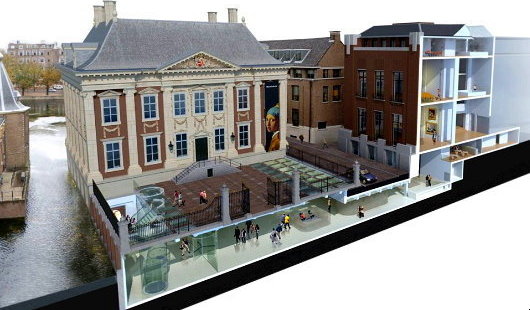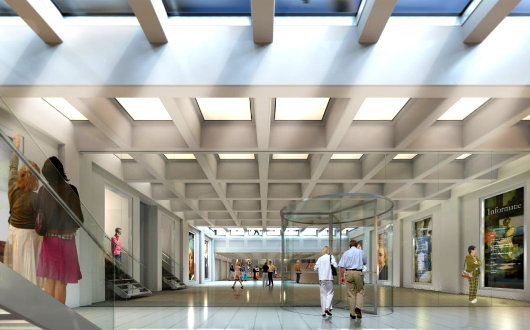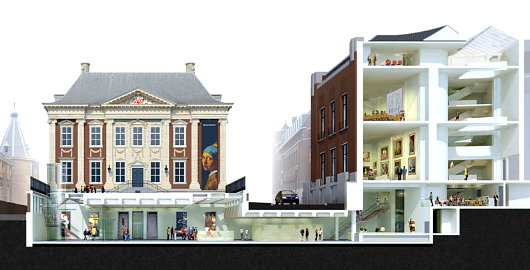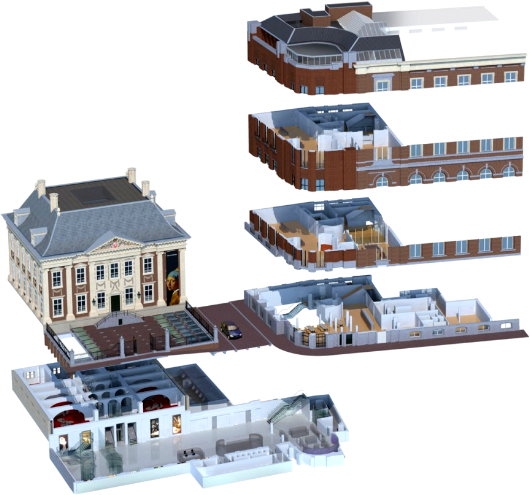
About Andrew Cusack
 Writer, web designer, etc.; born in New York; educated in Argentina, Scotland, and South Africa; now based in London.
Writer, web designer, etc.; born in New York; educated in Argentina, Scotland, and South Africa; now based in London. read more
News
Blogs
Reviews & Periodicals
Arts & Design
World
France
Mitteleuropa
Knickerbockers
Argentina
The Levant
Africa
Cape of Good Hope
Netherlands
Scandinavia
Québec
India
Muscovy
Germany
Academica

Mauritshuis Digs Deep
Art Gallery in the Heart of the Hague Unveils Expansion Plans
WELL, NOT THAT deep, really. The Mauritshuis museum in the Hague recently unveiled its plans to expand underground and across the street into a neighbouring building. The square-footage of the museum will double after the completion of the new project, which will include a new entrance, exhibition hall, café, and lecture theatre. The entrance to the museum, currently accessed from the side street, will return to the front of the Mauritshuis but underground rather than through the main doorway on the ground floor.
The building was originally constructed between 1636 and 1641 for Johan Maurits, Prince of Nassau-Siegen next to the Binnenhof palace. At the time, Prince Johan Maurits (a cousin of the stadtholder Frederik Henrik, Prince of Orange) was governor of the New Holland, the Dutch colony in Brazil. In 1820, the palace was purchased by the government to house the Royal Cabinet of Paintings. The Mauritshuis art museum was separated from the state by being transformed into a private foundation which enjoys the use of the building and the art collection on long-loan from the government.

Visitors will descend to the new underground foyer to purchase admission to the museum, visit the gift shop, or dine in the café. The subterranean level will also provide access to Plein 26, the building across the street in which the Mauritshuis is constructing new spaces for exhibition and education.

Plein 26 is part of the Nieuwe of Littéraire Sociëteit De Witte (New or Literary Society De Witte), one of the most prominent private clubs in the Hague. The Sociëteit was founded in the basement of the White (de Witte) coffeehouse in 1802. The current club building was built in 1870 with an art nouveau addition some years later, followed by an art deco expansion in 1930 of which Plein 26 is a part.
The Mauritshuis project is expected to be completed in 2014. The total cost should be around €220 million, which has been provided through the budget of the Royal Dutch Ministry of Education, Culture, and Science as well as receipts from touring exhibitions, grants from the BankGiro lottery, and the generosity of private individuals, funds, and institutions.

Previously: Russia’s Treasures on the Banks of the Amstel
Search
Instagram: @andcusack
Click here for my Instagram photos.Most Recent Posts
- Patrick in Parliament March 18, 2024
- Articles of Note: 13 March 2024 March 13, 2024
- Cambridge March 9, 2024
- Taken on Trust March 4, 2024
- Immanuel on the Green March 2, 2024
Most Recent Comments
Book Wishlist
Monthly Archives
Categories


